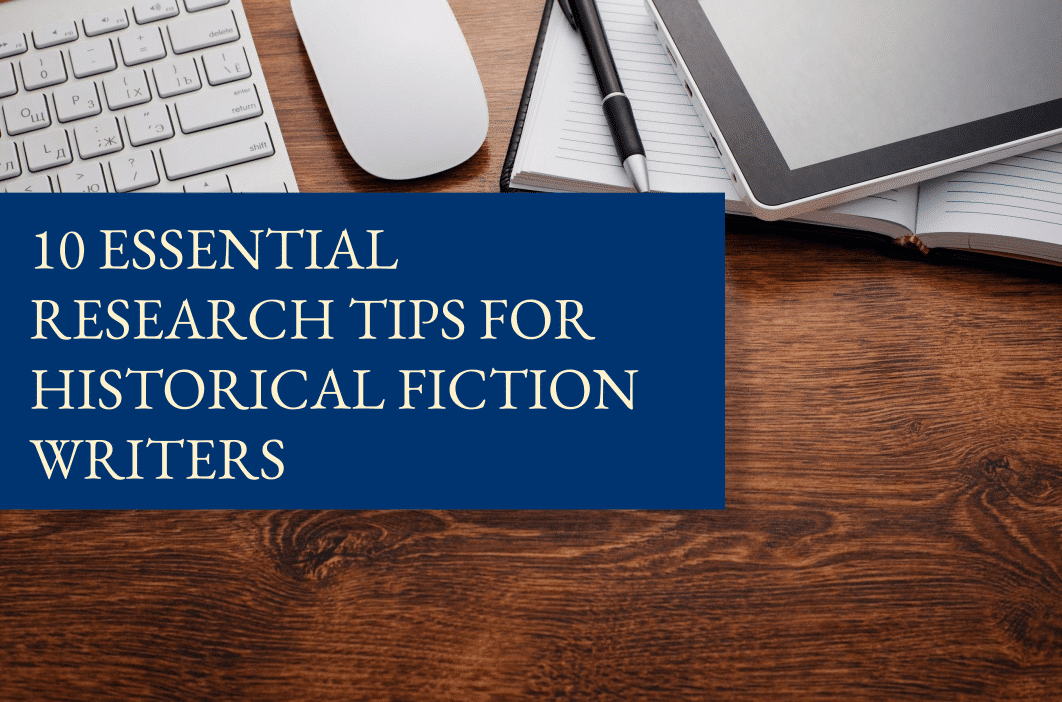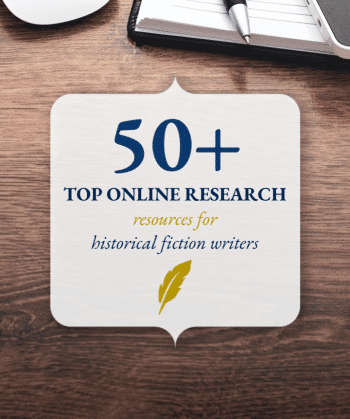10 essential research tips for historical fiction writers
by Andrew Noakes

One of the trickiest aspects of writing historical fiction is doing all the research required to create an immersive, authentic historical world.
To help ease the process, I’ve dusted off my historian’s hat and put together this guide featuring 10 essential historical fiction research tips. As an extra, I’ve also compiled a list of 50+ top online research resources for historical fiction writers. You can download it below.
50+ top online research resources for historical fiction writers

1) Start with a plan
Even if you’re a pantser, you should plan out your historical research in advance. If you don’t, you’re likely to miss things. Start by figuring out what you need to know, then research a list of sources that will help you get there. I advise listing them by type and/or focus (e.g. primary, secondary, political background, daily life, etc.)
2) Take notes and record sources
No matter how big your brain, you’re not going to be able to remember everything you read, so take notes. They don’t have to go on for hundreds of pages, and they don’t even have to be that well organised at first (you can sort that out later), but I would recommend keeping note of where vital bits of information come from. Believe me, you’ll need to refer back to your sources.
3) Cross-reference
One of the first things you need to know about historical sources – whether primary or secondary – is they can be wrong. Errors can range from small and annoying (incorrect dates, misspelled names etc.) to major and highly problematic (like ascribing historical events to the actions of the wrong people).
The important thing is to try and cross-reference everything you read, especially the important things like critical dates and key figures. You should even try and cross-reference small details like diet and clothing when you can. Mistakes in these areas can really put readers off.
4) Check the provenance
Sometimes, errors in historical sources stem from the agendas of those who wrote them. In truth, there’s no such thing as an unbiased source. Every piece of historical writing will, to some extent, be influenced by the outlook of its author and the trends of its time.
The most misleading sources, though, are those that deliberately obscure the truth. Some seek to absolve their authors of blame for a particular historical event; others may seek to cast false blame to damage someone’s reputation. The point is this: the likely purpose of a source affects how we should read it. So always check provenance.
5) When sources disagree…
Sometimes, two sources will contradict each other even though they both seem credible. This can be down to a legitimate difference in interpretation, and in those cases you can feel safe in siding with the interpretation that you find most convincing. You can also adopt your own interpretation, providing it’s plausible and you can back it up.
Occasionally, though, the contradiction occurs because one source has got something wrong. If you’re unable to cross-reference further (i.e. if there aren’t more than two credible sources), then you’ll have to make a judgement call. Which source has more consistently got things right? Which source has the greater authority? Consider these carefully and make a decision, then note the contradiction and your approach to resolving it in your historical note if you’re using one.
6) When there are no sources at all…
This is more and more likely to happen to you the further back your story is set. But try and turn it on its head for a second: remember, you’re not a historian. It’s part of your craft to fill in the gaps with your imagination. In fact, some of the best historical fiction stories grow between the cracks found in history.
If something cannot be known, then so long as your interpretation feels plausible, it’s entirely legitimate to chart your own path. Just make sure you explain the gaps and how you filled them in your historical note.
7) Strike a balance between primary and secondary sources
Primary sources can give you an authentic flavour of your chosen era, and they can help you to reproduce authentic voices in your story as well, to say nothing of their value in providing a deeper insight into historical events.
But secondary sources are also vital for providing you with a wider perspective on those events. Historians can assess things with the benefit of hindsight and through a broader lens.
In truth, you need to use a good mix of both primary and secondary sources in order to properly research your period.
8) Don’t just look for the facts, find the essence of your era as well
Sometimes, I read a manuscript and I just don’t feel ‘in the period’. It might be the way the characters speak to each other, it might be their social and political attitudes, or it might be their etiquette. Whatever the case, the story will feel off.
That’s why it’s important not just to learn the core facts of your period, but to immerse yourself in it as well. Historical fiction authors who do this well recommend reading diaries, newspapers, and other primary sources, investigating cultural artefacts like art and music, and even eating meals from your era!
9) Knowing when to start writing
When do you know you’ve reached that magic point where you’ve done enough research and you can finally start writing?
The truth is you’ll probably never know for sure. After all, there’s no truly objective way to measure it. But it helps to make a list of questions you think you need the answers to before you begin writing. Once those have been answered satisfactorily, you’ll know the time for writing is near.
10) Research while you write
Just because you’ve started writing, it doesn’t mean your research is over. You can – and should – continue to research while you write to enrich your understanding of your period and keep your knowledge fresh. Sometimes, a little bit of extra research can also ignite the flame of inspiration if you’re struggling with writer’s block.
So, there you have it. Those are my 10 essential research tips for historical fiction writers. I hope you find them useful as you research your next story. If you’re looking for more guidance, don’t forget to download our 50+ top online research resources as well.
P.S. Solid research is just one aspect of writing historical fiction. To learn about the others, make sure you read our dedicated guide, How to write historical fiction in 10 steps. You might also be interested in Top tips on writing historical fiction from 64 successful historical novelists.
50+ top online research resources for historical fiction writers

Do you write historical fiction?
Join our email list for regular writing tips, resources, and promotions.
